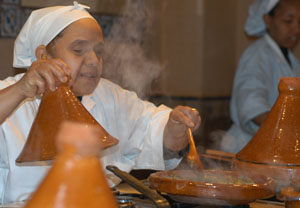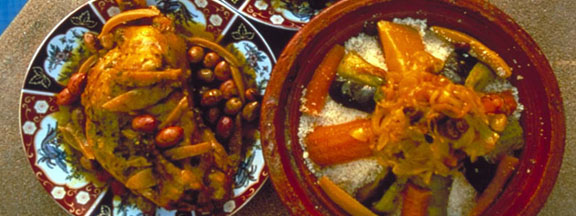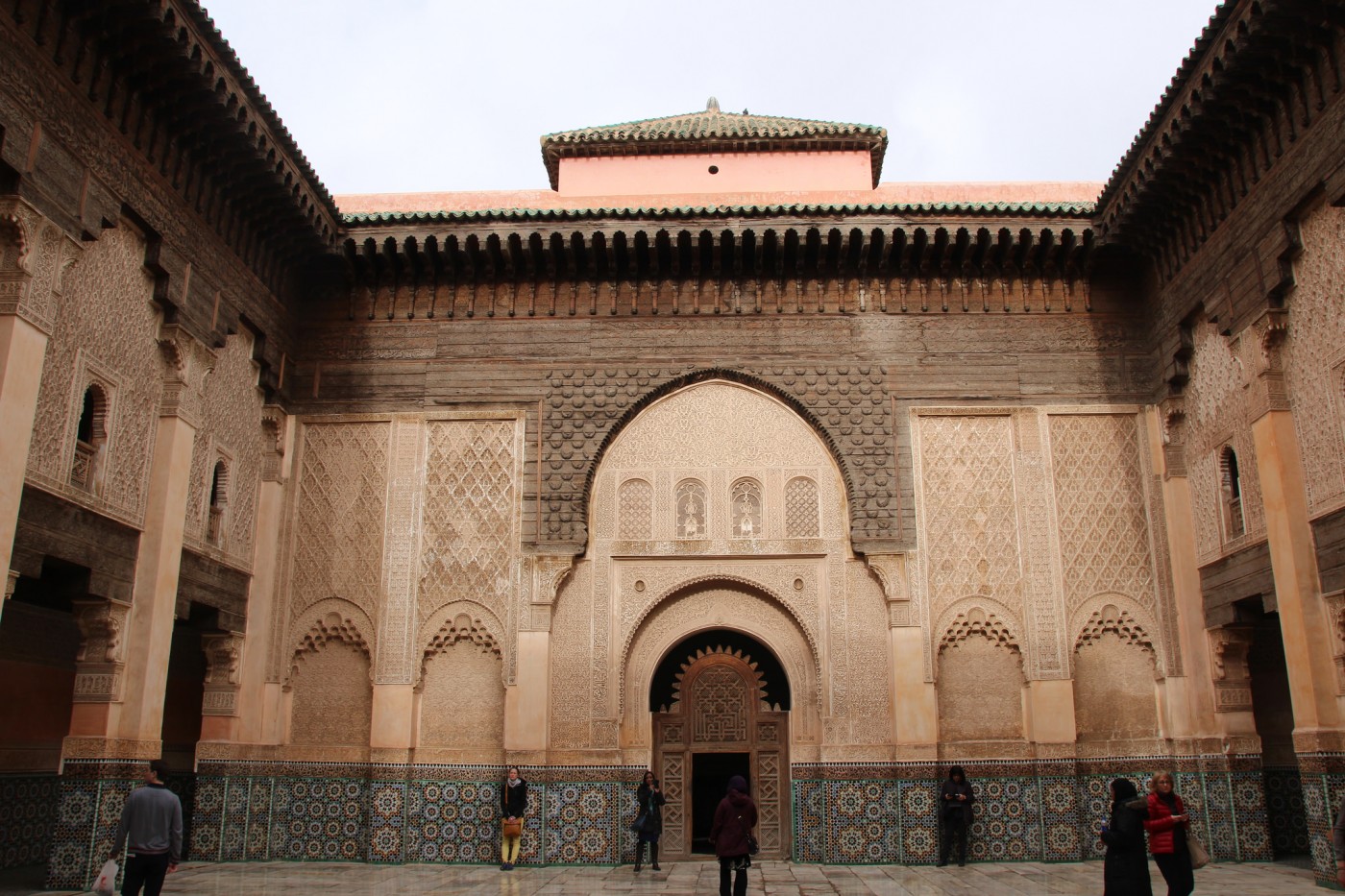Morocco’s Mixed Bag
When American expat writer Paul Bowles wrote that travelers to Morocco “expect mystery and they find it,” he must have been thinking of Marrakech and the High Atlas Mountains that stand sentinel over it. Morocco is only seven miles across the Straight of Gibraltar from Europe but it might as well be another world. Its ethnic and cultural diversity – African, Arab, Berber, Oriental, and, more recently, Spanish and French – makes America look homogenous.
Marrakech, named a culinary destination in 2009, is much more than food. Most people don’t even know that North Africa’s tallest peak is about 90 miles outside the city and there’s a ski resort close-by. Plus, for foodies looking for some outdoor fun, there aren’t many better destinations. Then of course there’s the happy coexistence of ancient and contemporary. One moment you’re in biblical times and the next you’re in a modern-day Parisian café served by a hip 20-something in heels. Or you find yourself facing off with a camel and his turban clad Berber master on a mountain trail.
While many visitors to Marrakech are happy to merely spectate and still return home with tales of amazing sights and meals, we recommend a more hands-on trip on both the food and the outdoor fronts.
Foodies
 If there’s a better way to enjoy Marrakech’s vibe than sitting on a hidden, poolside terrace just inside the ancient medina while eating a pastilla, a traditional Moroccan stuffed pie, it has yet to be discovered. Especially if the poolside terrace in question is the one belonging to La Maison Arabe, the city’s first boutique hotel when it opened in 1998. Although Moroccans usually favor the classic pastillas (also known as B’stilla) made with squab, chicken is sometimes substituted for visitors. Even if not enjoyed al fresco poolside, many visitors say this sweet and savory pie – many Moroccan dishes include hefty amounts of cinnamon – is one of the best things they’ve ever eaten. Alone it could account for Marrakech’s recognition as a great culinary destination.
If there’s a better way to enjoy Marrakech’s vibe than sitting on a hidden, poolside terrace just inside the ancient medina while eating a pastilla, a traditional Moroccan stuffed pie, it has yet to be discovered. Especially if the poolside terrace in question is the one belonging to La Maison Arabe, the city’s first boutique hotel when it opened in 1998. Although Moroccans usually favor the classic pastillas (also known as B’stilla) made with squab, chicken is sometimes substituted for visitors. Even if not enjoyed al fresco poolside, many visitors say this sweet and savory pie – many Moroccan dishes include hefty amounts of cinnamon – is one of the best things they’ve ever eaten. Alone it could account for Marrakech’s recognition as a great culinary destination.
Take a cooking class at Jnane Tamsna, a retreat that is just a short drive from Marrakech’s medina with several acres of organic gardens, and the teacher will explain the power of the pastilla which takes an entire day to make. So, Jnane Tamsna’s class instead teaches how to make an easier fish pastilla instead. It also teaches how to make an appetizer – perhaps Morocco’s version of gazpacho – and a dessert – maybe poached pears with caramel sauce. When finished all three courses take less than three hours to prepare and the meal is served under a canopy of white bougainvillea near one of the property’s five pools.

The culinary curious, however, can’t live on pastillas alone, no matter how much they adore them. The half-day cooking class at La Maison Arabe, also Marrakech’s first cooking school, tackles a tagine. On the day I attend, it’s a chicken tagine with olives and preserved lemons. Students can choose between taking a class in the medina or at La Maison’s “country club”, a 15-minute shuttle ride away. Wanting to do some post-class sunbathing and swimming, I opt for the latter. Similarly, La Maison students prepare and eat three courses. My class makes a roasted green pepper and tomato salad starter, properly called taktouka, served warm or cold. We serve it warm and since you can’t eat taktouka without Berber bread to soak up the leftover juices, we make some of that too. Think Indian chapati or pita then think it’s time to take a break from eating to explore the mountains.
Adventurists
Heralded as the most fabulous mountains in all of Africa the Atlas are the continent’s highest and most extensive range. If you’re thinking Kilimanjaro is Africa’s tallest peak, you’re right; but it’s a volcano rather than part of a mountain range. Stretching nearly 1,500 miles across Morocco, Tunisia, and Algeria, the Atlas are divided into sub-ranges. It’s the High Atlas range that is closest to Marrakech and is the most interesting for bikers, hikers and climbers.
Imlil is the Chamonix of the High Atlas. Enroute, stop for a night at Terres d’Amanar, a true eco adventure resort in the foothills (if sleeping in a Berber tent is resort-like). One hundred and seventy-three acres, Terres d’Amanar has mountain biking and hiking trails that cross over to adjacent Toubkal National Park, as well as two zip lines on-site (one is the longest in North Africa) and three ropes courses, each a different level. The rental bikes are better than you’d expect; front suspensions still have some snap. The hikes range from easy (meandering through the forest) to challenging (climbing a nearby summit). By the way, if the scenery looks familiar it’s because part of the Sean Connery movie “The Man Who Would Be King” was shot there. In between zipping and ripping, shop at the property’s open-air boutique, selling art, ceramic and paper products, all by local craftspeople.
Serious hikers should save themselves for Imlil though. Although this is Africa – a fact reinforced by the native Berber population clad in haiks, chalwar, and turbans and roaming all over these mountains – there are Euro-style overnight refuges and chalets all over the place. Two of these are within a day’s walking distance from Imlil’s town square. Visitors wanting to hike (technically, not a climb) to the summit of North Africa’s highest peak, the 13,600 foot Toubkal, can hire a mule and muleteer and head for the first, the Toubkal Refuge. The Lepiney Refuge, the second, in the upper Azzaden Valley, sees far fewer guests than Toubkal, possibly due to the fact that guests must check-in with the refuge’s guardian, who lives in a village down the valley, to make sure it’s unlocked. Trails lead in all directions from both refuges and it isn’t difficult to plan a weeklong refuge-to-refuge itinerary through Berber villages and past walnut groves, camel corrals, and even the occasional waterfall. You can also walk from here to the ski resort of Oukaimeden.
For details on specific hikes, the Cicerone guide Trekking in the Atlas Mountains is a good resource. Although it isn’t necessary to hire a guide, the undertaking will certainly go much better with the assistance of one.
As exotic as it is, Morocco is a cinch to reach. Casablanca is less than a seven-hour flight from New York City and Marrakech a 35-minute connection or two-hour drive. Visitors must present a passport to enter and exit but no visa is required for American citizens traveling fewer than 90 days. They are encouraged to carry a copy of their U.S. passport at all times in case of questioning by local officials.
Moroccan Arabic is the official language. While English is prevalent, French is widely spoken with Spanish often spoken in the north. The official currency is the Moroccan Dirham (MAD). In early December 2009, $1US equaled approximately 7.6 MAD. Credit cards are accepted at all hotels, restaurants, and activities listed below, but cash is often the only accepted payment in smaller shops and markets.
No vaccinations are required to enter Morocco.
Where to Sleep
La Maison Arabe – deluxe, 26-room Moorish style boutique hotel located inside the medina with an eclectic collection of art and antiques. Charming nooks and crannies as well as libraries and sitting rooms are decorated in the signature “tadelakt” Moroccan plaster. Heated pool. Complementary shuttle to the hotel’s country estate with ornamental gardens surrounding a tiled infinity pool. 1, Derb Assehbé, Bab Doukkala, Marrakech Médina, 212 524 387010 www.lamaisonarabe.com
Ana Yela – a small, 300 year old city palace transformed into a Design Hotel, located in the former Jewish Quarter. Three rooms and two suites surround a roofless, open plan inner courtyard with heated pool and lounge. Artisanal uber-chic décor with renowned calligraphic artist’s work decorating every door with an Arabic love poem. Roof-top terrace and bar with spectacular views and authentic Nomad tent with an open barbecue pit. Breakfast or dinner in the Tapis Volant (Flying Carpet), a small roof tower with panoramic views is an unforgettable experience. 28 Derb Zerwal, Marrakech, 212 524 386969, www.anayela.com
Jnane Tamsna – luxury villas offering elegant architecture, discreet hospitality and a sense of tranquility, located on 9 lushly landscaped acres within a private estate called the Palmeraie just outside Marrakech. A total of 24 suites and villas are outfitted completely in the New Moroccan Style using all natural materials, an unabashed use of color and traditional objects used in untraditional ways. Languid opulence is the letter of the hour here with tennis courts, an art gallery, and an herbal apothecary to boot.
Douar Abiad, La Palmeraie, Marrakech; 212 524 328484, www.jnanetamsna.com
Where to Eat
Dar Yacout – set deep within the medina, this is perhaps the most famous palace restaurant in Marrakech. The vast multi-course menu unites top quality Moroccan cuisine with traditional musical entertainment. Try the Arabian Night-esque 8 course meal of warm salads, Berber breads, tangine, kaliya, couscous, and pastillas, to name a few of the courses. 79 Rue Sidi Ahmed Soussi, Bab Doukkala, Medina, Marrakech, 212 44 382929
Le Restaurant – a unique and refined dining experience at La Maison Arabe featuring exclusively Moroccan food in a sumptuous setting complete with hand painted zouake ceiling. Arab-Andalusian music played on lute and guitar. Cocktails and live music in the Piano Bar.1, Derb Assehbé, Bab Doukkala, Marrakech Médina; 212 524 387010;
http://www.lamaisonarabe.com/uk_content/gastronomie-le-restaurant.php
Bo-Zin – a short taxi ride out of town, but worth it. Unique, dreamlike atmosphere, ask to sit in the Pergola. Appetizers like vegetable spring rolls with fresh tuna, main dishes like Mechoui lamb and famous molten chocolate “cigare” cake for dessert.
Route de l’ Ourika km 3,5 Marrakech; 212 24 388012; bo-zin.com.
What to See and Do
Jardin Majorelle – a hidden oasis in downtown Marrakech made famous by the designer, Yves Saint Laurent, who purchased it in 1980 and filled it with rare plants collected from around the world. Designed for sitting and relaxing. Café serving an extensive menu of drinks, light lunches, and snacks. Safi Boulevard Marrakech; 212 024 3018; www.jardinmajorelle.com.
Cooking Workshop – Cooking schools in Marrakech are plentiful but none beats La Maison Arabe’s. Workshops are a half-day and are conducted by a dada (traditional Moroccan cook) or a chef from their restaurant with the help of a translator. Classes are held either in the medina or at the hotel’s country club just outside of the city.
http://www.lamaisonarabe.com/uk_content/ateliers-cuisine.php

